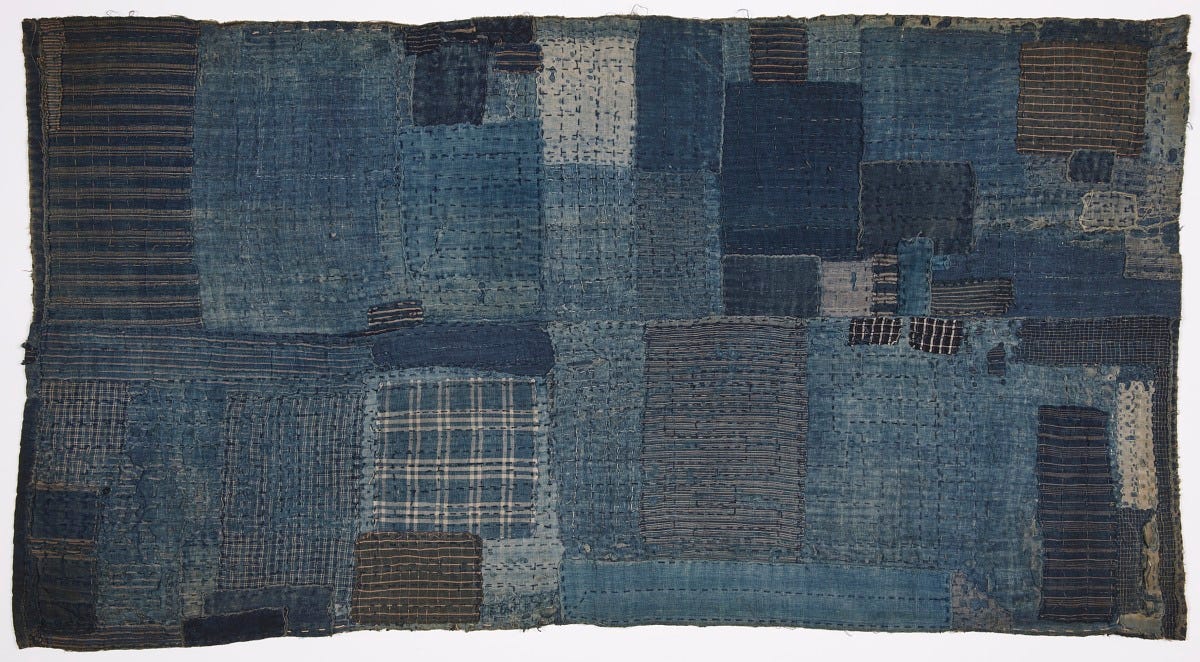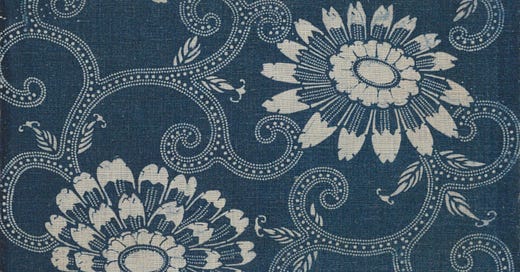Dear Reader,
Have you ever wondered about how your jeans turn blue?
Unless you’re a textile artist or designer, chances are you’ve never really thought about this question. The blue which is traditionally used to dye denim is called indigo, and it is one of the oldest dyes in the world.
Two weeks ago, despite having a long to-do-list and a busy schedule, I decided to see a film at a local festival, as I find it hard to concentrate in the afternoon anyway. And it turned out to be the best afternoon I’ve had in a long while: The screening was the German premiere of the 2024 documentary “Shades of Indigo” by Japanese filmmaker Shigeru Yoshida.
The film primarily follows one of the last remaining traditional indigo dyers in Japan, but it also introduces us to a variety of people who work with indigo in different ways: farmers, dyers, weavers, and researchers. Beyond that, the cinematography of the documentary is incredibly soothing (especially for a person who sits in front of a computer every day), capturing the rhythm of harvesting, dyeing, and weaving through beautifully composed shots:
If the film ever gets international distribution, I highly recommend watching it. But since documentaries about niche topics (and unfortunately, “design” and “craft” are still considered niche by most film distributors) don’t always reach a wide audience, I’ve put together six surprising indigo facts:

Indigo is one of the oldest (and most popular) dyes in the world.
The oldest known textile dyed with indigo is over 6,000 years old and was discovered in northern Peru. But indigo dye was also used by ancient civilizations in Mesopotamia, Egypt, Britain, Mesoamerica, Iran, and West Africa. Some Egyptian mummies, dating back around 4,400 years, were wrapped in indigo-dyed bands.
Indigo can be extracted from a variety of plants around the globe, but most natural indigo came from plants in the Indigofera genus, which usually grow in tropical regions. Since these plants were widespread in India, India became a major supplier of indigo dye to Europe as far back as antiquity.

In ancient Japanese, almost every color was described as “blue.”
As a tea drinker, I’ve often wondered why Chinese oolong teas are sometimes referred to as “blue tea.” While watching “Shades of Indigo”, I learned that in ancient Japanese, there were likely only three distinct words used to describe specific colors: red, black, and white. All other hues (including shades we’d now call green, gray, or purple) were grouped under the word for “blue.” When indigo was introduced to Japan from China around 1,500 years ago, it dramatically reshaped the Japanese perception of the color blue.
Traditional indigo dye is a living entity.
When I think of Japanese fermented goods, I think of miso, soy sauce, mirin (rice wine), pickled vegetables, and rice vinegar. I certainly never would’ve thought of indigo dye.
However, the documentary “Shades of Indigo” follows self-taught indigo dyer Ryuta Sasaki, who practices a traditional dyeing technique that involves mixing crushed indigo leaves with wood ash and water to kickstart the fermentation process. Over time, the indigo dye becomes a living entity (similar to a sourdough starter), with its color changing slightly from day to day. Experienced dyers can even sense the “mood” of the dye by its smell and taste. One of the most moving scenes in the documentary shows Sasaki expressing gratitude and saying goodbye to an old indigo vat he had affectionately named “Great-Grandma” after she stopped producing color—a reflection of the deep bond he had formed with it.

Traditional indigo dyeing is naturally circular and zero-waste.
After saying goodbye to his indigo dye, Sasaki spreads the fermented leaves out in the sun to dry. Because only natural materials are used in the dye-making process, the dried indigo leaves can be returned to the fields as fertilizer, making traditional indigo dyeing a completely closed-loop, zero-waste system.

Modern synthetic indigo was first created by a German chemist.
As you can imagine, a dye that changes color from day to day and performs best when it’s nurtured and spoken to regularly isn’t exactly seen as reliable by Western industrial standards. In the documentary, the UK-based textile researcher Linda Brassington explains that “the Western idea and obsession with control and regularity don’t go well with the inconsistency of indigo; in Japanese heritage, cloth has a life and mutates over time.”
In 1878, German chemist Adolf von Baeyer discovered a way to synthesize indigo. He was later awarded the Nobel Prize in Chemistry in 1905 for his work. Von Baeyer sold the patent to the German company BASF, which went on to produce “Indigo Pure” until the late 2000s.

Will your future jeans be dyed with E. coli?
Despite its innocent-sounding name, “Indigo Pure,” the synthetic indigo produced in chemical labs is actually petroleum-based and derived from aniline, a compound that can be harmful to both the environment and to the people who work with it. (Chances are, the jeans you’re wearing right now were dyed using this type of indigo.)
In response, scientists are exploring more eco-friendly alternatives. In Shades of Indigo, we meet researcher Masashi Shimizu from the Osaka Research Institute of Industrial Science and Technology, who is developing a synthetic “bio-indigo” made from bacteria.
I was already familiar with the concept of dyeing with bacteria from interviewing textile designer Natsai Audrey Chieza in 2021. Since 2011, Chieza and her studio, Faber Futures, have been experimenting with the bacteria Streptomyces coelicolor to create textiles with purple organic-looking gradients and color shifts.
However, Shimizu is taking a different approach: By genetically modifying E. coli bacteria to produce indigo, he hopes to develop a sustainable, environmentally friendly alternative to conventional synthetic dyes that can be used on a bigger scale.
Getting myself an Indigo starter now,
Nina






1) love the pun in the title 2) love all of the cooper hewitt examples